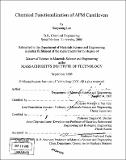| dc.contributor.advisor | Krystyn J. Van Vliet. | en_US |
| dc.contributor.author | Lee, Sunyoung, S.M. Massachusetts Institute of Technology | en_US |
| dc.contributor.other | Massachusetts Institute of Technology. Dept. of Materials Science and Engineering. | en_US |
| dc.date.accessioned | 2006-09-28T15:18:20Z | |
| dc.date.available | 2006-09-28T15:18:20Z | |
| dc.date.copyright | 2005 | en_US |
| dc.date.issued | 2005 | en_US |
| dc.identifier.uri | http://hdl.handle.net/1721.1/34205 | |
| dc.description | Thesis (S.M.)--Massachusetts Institute of Technology, Dept. of Materials Science and Engineering, 2005. | en_US |
| dc.description | Includes bibliographical references (p. 47-52). | en_US |
| dc.description.abstract | Atomic force microscopy (AFM) has been a powerful instrument that provides nanoscale imaging of surface features, mainly of rigid metal or ceramic surfaces that can be insulators as well as conductors. Since it has been demonstrated that AFM could be used in aqueous environment such as in water or various buffers from which physiological condition can be maintained, the scope of the application of this imaging technique has been expanded to soft biological materials. In addition, the main usage of AFM has been to image the material and provide the shape of surface, which has also been diversified to molecular-recognition imaging - functional force imaging through force spectroscopy and modification of AFM cantilevers. By immobilizing of certain molecules at the end of AFM cantilever, specific molecules or functionalities can be detected by the combination of intrinsic feature of AFM and chemical modification technique of AFM cantilever. The surface molecule that is complementary to the molecule at the end of AFM probe can be investigated via specificity of molecule-molecule interaction. | en_US |
| dc.description.abstract | (cont.) Thus, this AFM cantilever chemistry, or chemical functionalization of AFM cantilever for the purpose of chemomechanical surface characterization, can be considered as an infinite source of applications important to understanding biological materials and material interactions. This thesis is mainly focused on three parts: (1) AFM cantilever chemistry that introduces specific protocols in details such as adsorption method, gold chemistry, and silicon nitride cantilever modification; (2) validation of cantilever chemistry such as X-ray photoelectron spectroscopy (XPS), AFM blocking experiment, and fluorescence microscopy, through which various AFM cantilever chemistry is verified; and (3) application of cantilever chemistry, especially toward the potential of force spectroscopy and the imaging of biological material surfaces. | en_US |
| dc.description.statementofresponsibility | by Sunyoung Lee. | en_US |
| dc.format.extent | 52 p. | en_US |
| dc.format.extent | 3055388 bytes | |
| dc.format.extent | 3056447 bytes | |
| dc.format.mimetype | application/pdf | |
| dc.format.mimetype | application/pdf | |
| dc.language.iso | eng | en_US |
| dc.publisher | Massachusetts Institute of Technology | en_US |
| dc.rights | M.I.T. theses are protected by copyright. They may be viewed from this source for any purpose, but reproduction or distribution in any format is prohibited without written permission. See provided URL for inquiries about permission. | en_US |
| dc.rights.uri | http://dspace.mit.edu/handle/1721.1/7582 | |
| dc.subject | Materials Science and Engineering. | en_US |
| dc.title | Chemical functionalization of AFM cantilevers | en_US |
| dc.title.alternative | Chemical functionalization of atomic force microscopy cantilevers | en_US |
| dc.type | Thesis | en_US |
| dc.description.degree | S.M. | en_US |
| dc.contributor.department | Massachusetts Institute of Technology. Department of Materials Science and Engineering | |
| dc.identifier.oclc | 71300807 | en_US |
